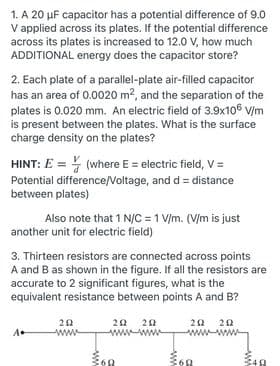1. A 20 µF capacitor has a potential difference of 9.0 V applied across its plates. If the potential difference across its plates is increased to 12.0 V, how much ADDITIONAL energy does the capacitor store? 2. Each plate of a parallel-plate air-filled capacitor has an area of 0.0020 m2, and the separation of the plates is 0.020 mm. An electric field of 3.9x106 V/m is present between the plates. What is the surface charge density on the plates?
1. A 20 µF capacitor has a potential difference of 9.0 V applied across its plates. If the potential difference across its plates is increased to 12.0 V, how much ADDITIONAL energy does the capacitor store? 2. Each plate of a parallel-plate air-filled capacitor has an area of 0.0020 m2, and the separation of the plates is 0.020 mm. An electric field of 3.9x106 V/m is present between the plates. What is the surface charge density on the plates?
College Physics
10th Edition
ISBN:9781285737027
Author:Raymond A. Serway, Chris Vuille
Publisher:Raymond A. Serway, Chris Vuille
Chapter16: Electrical Energy And Capacitance
Section: Chapter Questions
Problem 35P: a parallel-plate capacitor with area 0.200 m2 and plate separation of 3.00 mm is connected to a...
Related questions
Concept explainers
Dielectric Constant Of Water
Water constitutes about 70% of earth. Some important distinguishing properties of water are high molar concentration, small dissociation constant and high dielectric constant.
Electrostatic Potential and Capacitance
An electrostatic force is a force caused by stationary electric charges /fields. The electrostatic force is caused by the transfer of electrons in conducting materials. Coulomb’s law determines the amount of force between two stationary, charged particles. The electric force is the force which acts between two stationary charges. It is also called Coulomb force.
Question
2

Transcribed Image Text:1. A 20 µF capacitor has a potential difference of 9.0
V applied across its plates. If the potential difference
across its plates is increased to 12.0 V, how much
ADDITIONAL energy does the capacitor store?
2. Each plate of a parallel-plate air-filled capacitor
has an area of 0.0020 m2, and the separation of the
plates is 0.020 mm. An electric field of 3.9x106 V/m
is present between the plates. What is the surface
charge density on the plates?
HINT: E = (where E = electric field, V =
Potential difference/Noltage, and d = distance
between plates)
Also note that 1 N/C = 1 V/m. (V/m is just
another unit for electric field)
3. Thirteen resistors are connected across points
A and B as shown in the figure. If all the resistors are
accurate to 2 significant figures, what is the
equivalent resistance between points A and B?
20 20
wwwwww
22 20
wwwww
www
Expert Solution
This question has been solved!
Explore an expertly crafted, step-by-step solution for a thorough understanding of key concepts.
Step by step
Solved in 2 steps with 2 images

Knowledge Booster
Learn more about
Need a deep-dive on the concept behind this application? Look no further. Learn more about this topic, physics and related others by exploring similar questions and additional content below.Recommended textbooks for you

College Physics
Physics
ISBN:
9781285737027
Author:
Raymond A. Serway, Chris Vuille
Publisher:
Cengage Learning


College Physics
Physics
ISBN:
9781938168000
Author:
Paul Peter Urone, Roger Hinrichs
Publisher:
OpenStax College

College Physics
Physics
ISBN:
9781285737027
Author:
Raymond A. Serway, Chris Vuille
Publisher:
Cengage Learning


College Physics
Physics
ISBN:
9781938168000
Author:
Paul Peter Urone, Roger Hinrichs
Publisher:
OpenStax College

Physics for Scientists and Engineers with Modern …
Physics
ISBN:
9781337553292
Author:
Raymond A. Serway, John W. Jewett
Publisher:
Cengage Learning

Physics for Scientists and Engineers, Technology …
Physics
ISBN:
9781305116399
Author:
Raymond A. Serway, John W. Jewett
Publisher:
Cengage Learning

College Physics
Physics
ISBN:
9781305952300
Author:
Raymond A. Serway, Chris Vuille
Publisher:
Cengage Learning